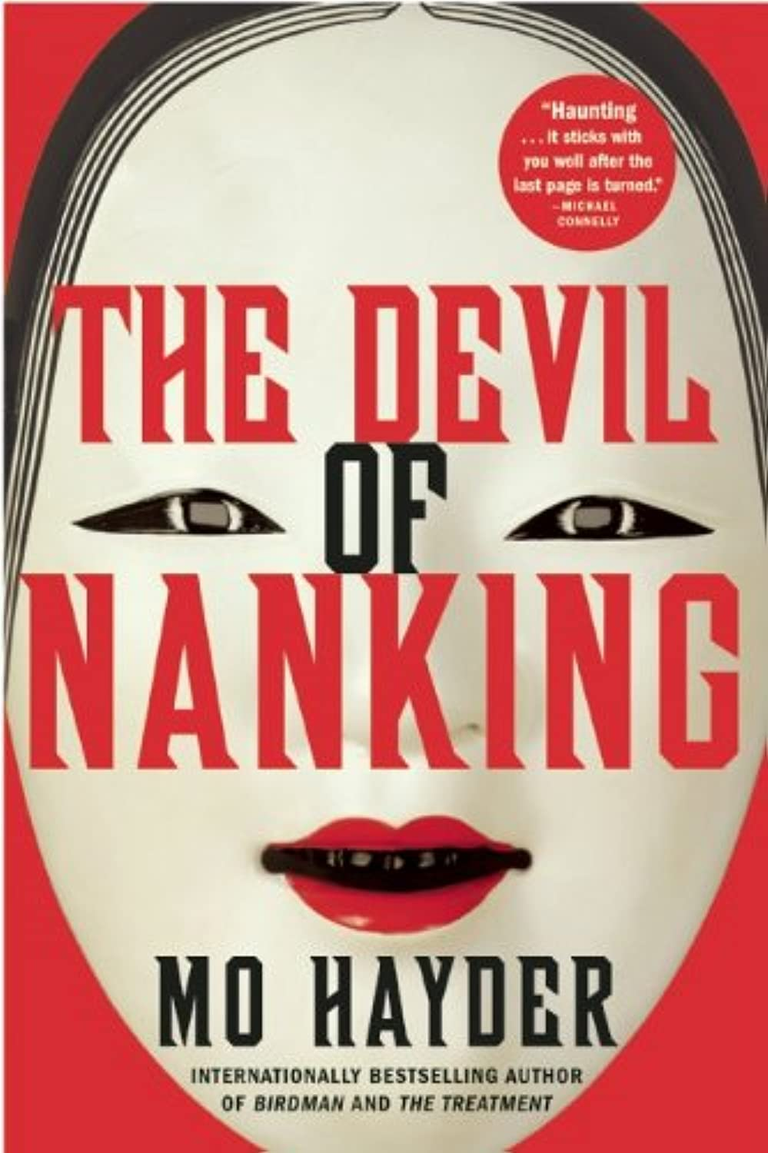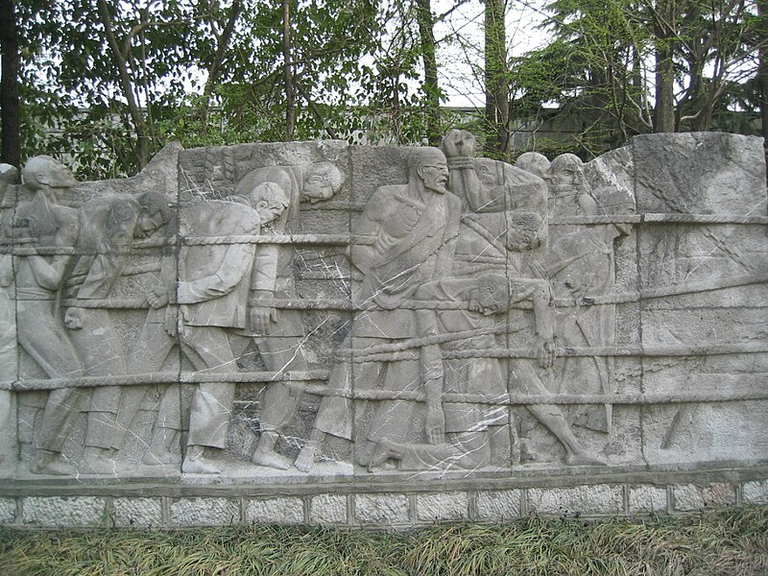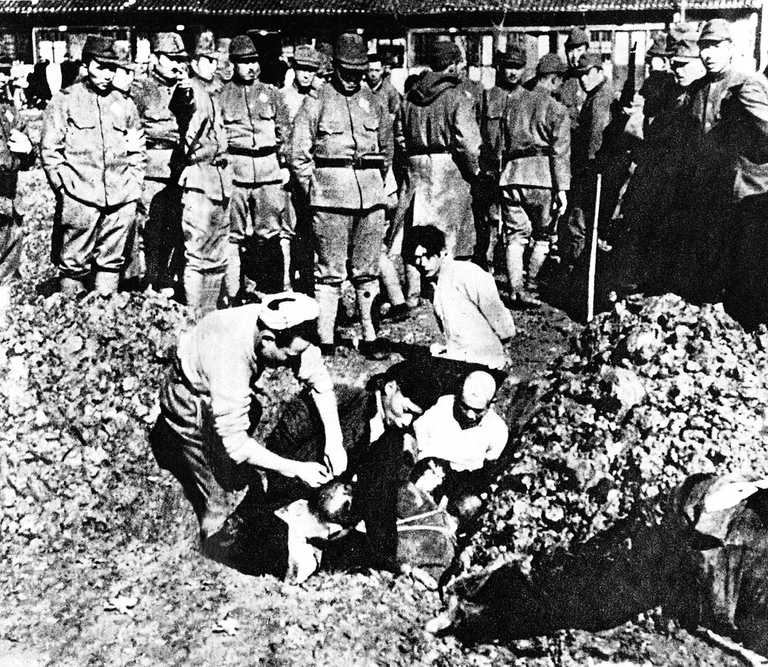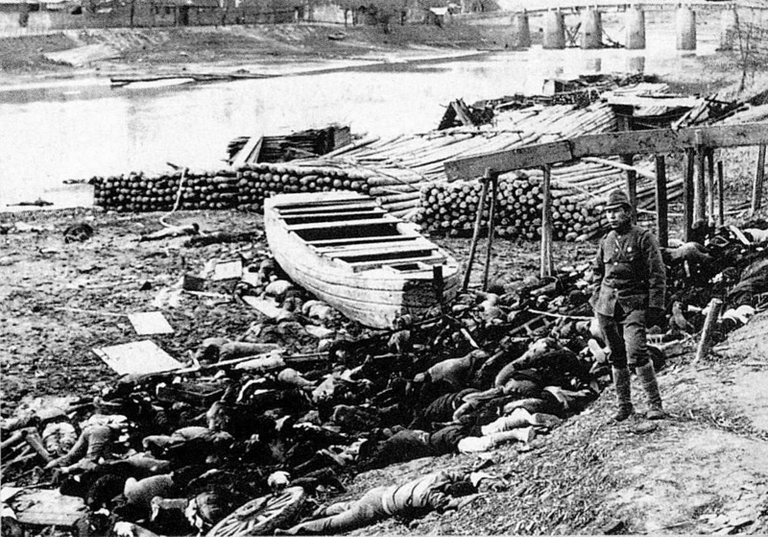
Researching the Nanjing massacre involves terrible difficulties, especially since there have been several attempts to cover up the truth. For my book I relied heavily on the work of two writers, Iris Chang and Katsuichi Honda: Chang, author of The Rape of Nanking, is a Chinese-American who has invested all his energies in trying to inform the American public about the events of ‘37; while Honda, with commendable courage, has spent thirty years trying to spread the truth about what happened to large sections of the Japanese population. He is forced to live in anonymity for fear of reprisals.
The book oscillates between the present and the past, between China in the 1930s and Japan in the 1990s. For the reconstruction of present-day Japan, the experience I gained in Tokyo, where I worked for some time in a bar some twenty years ago, was invaluable. However, I decided to return in 2002 to refresh my memory and to become aware of the changes that had taken place in the entraînause clubs after the murder of Lucie Blackman, an English girl killed by a club patron. I did my best to locate the place where Lucie had worked, but it was not easy because the club had changed its name in the meantime. It was a tough walk (anyone who knows the Roppongi neighbourhood will easily understand what I mean), but it was worth it because my effort was rewarded.
The information gathered from the girls and customers of the club, some of whom remembered both Lucie and her killer, helped me to realistically describe Grey's activity in the nightclub. On the historical side, I visited Nanjing and was also fortunate enough to meet, on the train I took to Shanghai, a former Japanese fighter who had participated in the invasion of China and was anxious to atone for his sins. his army had been tainted. A singular coincidence and a favourable encounter because it suggested new ideas for the novel.
Shi Chongming is an elderly university professor who visits Todai, a prestigious university in Tokyo, while Gray is a young Englishwoman who travels to Japan with the aim of getting hold of an unpublished film, which would bear witness to the atrocities perpetrated by the Japanese soldiers in Nanjing. At first glance, the two seem to belong to separate worlds, but when Gray and Shi Chongming investigate their past and try to come to terms with it, they discover that they have much more in common than they could have imagined.

La investigación de la masacre de Nanjing entraña dificultades terribles, sobre todo porque ha habido varios intentos de encubrir la verdad. Para mi libro me basé plenamente en los trabajos de dos escritores, Iris Chang y Katsuichi Honda: Chang, autor de La violación de Nanking, es un chino-estadounidense que ha invertido todas sus energías en tratar de informar a la opinión pública estadounidense sobre los hechos de '37; mientras que Honda, con encomiable valentía, lleva treinta años intentando difundir la verdad sobre lo sucedido a grandes sectores de la población japonesa. Se ve obligado a vivir en el anonimato por miedo a represalias.
El libro oscila entre el presente y el pasado, entre la China de los años treinta y el Japón de los noventa. Para la reconstrucción del Japón actual, fue muy valiosa la experiencia que adquirí en Tokio, donde trabajé durante algún tiempo en un bar hace unos veinte años. Sin embargo, decidí regresar en 2002 para refrescar mi memoria y para darme cuenta de los cambios que se habían producido en los clubes de entraînause tras el asesinato de Lucie Blackman, una chica inglesa asesinada por un cliente de un club. Hice todo lo posible para localizar el lugar donde había trabajado Lucie, pero no fue nada fácil porque el club había cambiado de nombre entretanto. Realicé una dura caminata (cualquiera que conozca el barrio de Roppongi entenderá fácilmente a qué me refiero), pero valió la pena porque mi esfuerzo fue recompensado.
La información recopilada de las chicas y clientes del club, algunos de los cuales recordaban tanto a Lucie como a su asesino, me sirvió para describir de manera realista la actividad de Grey en el club nocturno. En cuanto a la parte histórica, visité Nanjing y también tuve la suerte de encontrarme, en el tren que cogí hacia Shanghai, con un ex combatiente japonés que había participado en la invasión de China y estaba ansioso por expiar sus pecados. su ejército había sido manchado. Una coincidencia singular y un encuentro favorable porque sugirió nuevas ideas para la novela.
Shi Chongming es un anciano profesor universitario que visita Todai, una prestigiosa universidad de Tokio, mientras que Gray es una joven inglesa que viaja a Japón con el objetivo de hacerse con una película inédita, que testimoniaría las atrocidades perpetradas por el Soldados japoneses en Nanjing. A primera vista, los dos parecen pertenecer a mundos separados, pero cuando Gray y Shi Chongming investigan su pasado y tratan de aceptarlo, descubren que tienen mucho más en común de lo que podrían haber imaginado.

What is the link between Gray's story, twenty years old and already the keeper of a terrible secret, and the atrocities committed in 1937 by the Japanese army in Nanjing?
Following the trail of a witness who survived a tragedy that the history books try to hide, Gray arrives in Tokyo, following a trail that leads her to work as a hostess in the places of vice frequented by the underworld.
And here, amidst powerful gangsters and ambiguous characters, monstrous in both appearance and soul, the young woman gets to the heart of ‘her’ mystery, taking risks and facing rituals and realities she had never even imagined .
Sometimes you have to go a long way if you want to prove something, even if only to yourself. A road that Gray has already been travelling for nine years, seven months and eighteen days and that is destined to become much more arduous and risky than she imagined, as it takes her from London to cross continents and time in the footsteps of Shi Chongming, an elderly Chinese professor now visiting a well-known university in Tokyo.
Having survived the Nanjing massacre in 1937, during the occupation by Japanese troops, Chongming is the only one who can help her: in fact, he has an unpublished film that would testify to the atrocities committed by the soldiers and, in particular, one brutal detail. so Gray owes all costs to uncover the truth.
Her mental health and her future are at stake, for that detail is capable of revealing the enigma of the disturbing scars she herself bears on her belly. However, faced with the reluctance of the professor, who refuses to even admit the existence of the film, Gray finds herself alone and desperate in a completely foreign city, and ends up working in a nightclub run by an unlikely Japanese Marilyn Monroe lookalike.
But Gray and Chingming's path is destined to be inextricably linked, for only by joining forces can they redeem their existence: and the cornerstone of this difficult and inevitable alliance is a feared and cruel character, the head of one of the most powerful Yakuza Families. A man surrounded by a host of terrifying stories about the mysterious medicine that keeps him alive despite his age and ill health, and who occasionally frequents the most prestigious nightclubs in the glittering Japanese metropolis. The city in whose bowels lies the dark secret that Gray must uncover in order to access the truth and, perhaps, free herself from the past. As long as she is willing to move on.

¿Qué vínculo existe entre la historia de Grey, veinte años y ya depositario de un terrible secreto, y las atrocidades cometidas en 1937 por el ejército japonés en Nanjing?
Siguiendo la pista de una testigo que sobrevivió a una tragedia que los libros de historia intentan ocultar, Gray llega a Tokio, siguiendo un rastro que la lleva a trabajar como anfitriona en los lugares de vicio frecuentados por el inframundo.
Y aquí, entre gánsteres muy poderosos y personajes ambiguos, monstruosos tanto en apariencia como en alma, la joven llega al corazón de "su" misterio arriesgándose y enfrentándose a rituales y realidades que ni siquiera había imaginado. .
A veces tienes que recorrer un largo camino si quieres demostrar algo, aunque sea solo a ti mismo. Un camino que Gray ya recorre desde hace nueve años, siete meses y dieciocho días y que está destinado a volverse mucho más arduo y arriesgado de lo que imagina, pues desde Londres la lleva a cruzar continentes y tiempo tras los pasos de Shi Chongming. un anciano profesor chino que ahora visita una conocida universidad de Tokio.
Habiendo sobrevivido a la masacre de Nanjing en 1937, durante la ocupación de las tropas japonesas, Chongming es el único que puede ayudarla: de hecho, tiene una película inédita que testimoniaría las atrocidades cometidas por los soldados y, en particular, un detalle brutal. por lo que Gray debe todos los costos para descubrir la verdad.
Su salud mental y su futuro están en juego, pues ese detalle es capaz de revelar el enigma de las inquietantes cicatrices que ella misma porta en su vientre. Sin embargo, ante la reticencia del profesor, que se niega incluso a admitir la existencia de la película, Gray se encuentra sola y desesperada en una ciudad completamente extranjera, y acaba trabajando en un club nocturno regentado por un improbable doble japonés de Marilyn Monroe.
Pero el camino de Gray y Chingming está destinado a estar indisolublemente ligado, ya que sólo uniendo fuerzas podrán redimir su existencia: y la piedra angular de esta difícil e inevitable alianza es un personaje temido y cruel, el jefe de uno de los Familias más poderosas de la Yakuza. Un hombre rodeado de un montón de terroríficas historias sobre la misteriosa medicina que le mantiene con vida a pesar de su edad y mala salud, y que en ocasiones frecuenta los clubes de ocio más prestigiosos de la rutilante metrópoli japonesa. La ciudad en cuyas entrañas se esconde el oscuro secreto que Gray deberá descubrir para acceder a la verdad y, tal vez, liberarse del pasado. Siempre y cuando ella esté dispuesta a seguir adelante.

In his third novel, Tokyo Nights, Mo Hayder moves away from the detective genre and experiments with new narrative solutions. The English writer bids farewell to the figure of detective Jack Caffery, the protagonist of Birdman and The Treatment, to tell a story of blood and violence that has firm roots in history. Nanjing, 1937: Japanese troops invade the ancient Chinese capital, subjecting civilians - including women and children - to rape, torture and mass execution. Tokyo, 1990: Grey, a young student suffering from mental disorders, arrives in Japan hoping to locate Shi Chongming, an esteemed Chinese professor who miraculously survived the Nanjing Massacre. Discovering the truth about that episode is an obsession for Grey, a reason to live, an indispensable necessity because his mental health and a large part of his future will depend on the correct reconstruction of the events. We asked the author a few questions. Q. Tokyo Nights is a very different novel from the previous ones. Although the atmospheres and themes are classic thrillers, the book is largely based around a tragic historical event dating back to the 1930s.

En su tercera novela, Tokyo Nights, Mo Hayder se aleja del género policial experimentando con nuevas soluciones narrativas. El escritor inglés se despide de la figura del detective Jack Caffery, protagonista de Birdman y The Treatment, para contar una historia de sangre y violencia que tiene firmes orígenes en la historia. Nanjing, 1937: las tropas japonesas invaden la antigua capital china, sometiendo a civiles -incluidos mujeres y niños- a violaciones, torturas y ejecuciones masivas. Tokio, 1990: Grey, un joven estudiante que sufre trastornos mentales, llega a Japón con la esperanza de localizar a Shi Chongming, un estimado profesor chino que sobrevivió milagrosamente a la masacre de Nanjing. Descubrir la verdad sobre aquel episodio es una obsesión para Grey, una razón de vivir, una necesidad indispensable porque de la correcta reconstrucción de los hechos dependerá su salud mental y gran parte de su futuro. Le hicimos algunas preguntas al autor. P. Noches de Tokio es una novela muy distinta a las anteriores. Aunque las atmósferas y los temas son clásicos del thriller, el libro se basa en gran medida en torno a un trágico acontecimiento histórico que se remonta a la década de 1930.

Source images / Fuente imágenes.Mo Hayder
Telegram and Whatsapp
Thanks @blurtconnect-ng!!
Upvoted. Thank You for sending some of your rewards to @null. Get more BLURT:
@ mariuszkarowski/how-to-get-automatic-upvote-from-my-accounts@ blurtbooster/blurt-booster-introduction-rules-and-guidelines-1699999662965@ nalexadre/blurt-nexus-creating-an-affiliate-account-1700008765859@ kryptodenno - win BLURT POWER delegationNote: This bot will not vote on AI-generated content
Thanks!